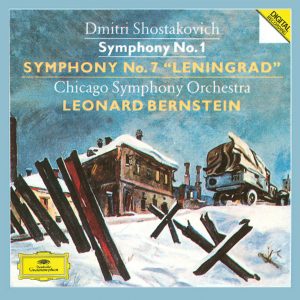
Leonard Bernstein made several appearances with the Chicago Symphony at the Ravinia Festival between 1944 and 1956, and he also conducted the Orchestra on two subscription weeks at Orchestra Hall in 1951. In June 1988, he returned to Chicago to act as artistic advisor for the American Conductors Program, a joint project of the American Symphony Orchestra League and selected major American orchestras. For the program, he coached three young conductors—Kate Tamarkin, Leif Bjaland, and John Fiore, all chosen following a nationwide competition—in works by Richard Strauss.
On the June 16 and 17 concerts with the Orchestra, Fiore conducted Death and Transfiguration, Tamarkin led Don Juan, and Bjaland conducted Till Eulenspiegel’s Merry Pranks. After intermission, Bernstein took the podium for Shostakovich’s Symphony no. 1, and the following week, he closed the Orchestra’s ninety-seventh season with Shostakovich’s Seventh Symphony (Leningrad) on June 21 and 22.
 “I cannot recall a season finale of recent years, in fact, that sent the audience home on such a tidal wave of euphoria, and for so many of the right reasons,” wrote John von Rhein in the Chicago Tribune, following the first performance of the Leningrad Symphony. “Indeed, the conductor was constantly pushing the music beyond the rhetorical brink, then drawing back when things threatened to go over the top. Of course, he had the world’s greatest Shostakovich brass section at his ready command. The augmented brasses blared with magnificent menace, the violins sounded their unison recitatives with vehement intensity. And the woodwinds, with their always crisp and characterful playing, reminded us of the many poetic, soft sections that separate the bombastic outbursts.”
“I cannot recall a season finale of recent years, in fact, that sent the audience home on such a tidal wave of euphoria, and for so many of the right reasons,” wrote John von Rhein in the Chicago Tribune, following the first performance of the Leningrad Symphony. “Indeed, the conductor was constantly pushing the music beyond the rhetorical brink, then drawing back when things threatened to go over the top. Of course, he had the world’s greatest Shostakovich brass section at his ready command. The augmented brasses blared with magnificent menace, the violins sounded their unison recitatives with vehement intensity. And the woodwinds, with their always crisp and characterful playing, reminded us of the many poetic, soft sections that separate the bombastic outbursts.”
Both of Shostakovich’s symphonies were recorded live by Deutsche Grammophon and the subsequent release received the 1990 Grammy Award for Best Orchestral Performance.
Image above: Leonard Bernstein in rehearsal with the Orchestra in June 1988 (Jim Steere photo)
This article also appears here.